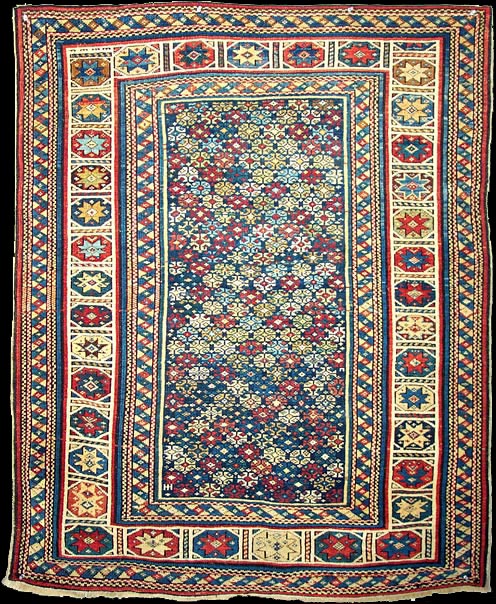 |
An unusual
Chichi carpet, southern Kuba region, last quarter of the 19th century, 3' 6"
x 4' 5", Herati Gallery
Shirvan-Kuba Rug
Northeast Caucasus, Shirvan Region
Circa 1875
Description:
Western rug literature has familiarized us with the 'infinite or endless
repeat' field design.
The design, in its various mutations, is found over a broad geographical
range of the rug weaving world.
Too often, the design is nothing more than a single field motif repeated
over and over again vertically, horizontally or, on occasion, diagonally.
Not surprisingly, many find the result to be simply mundane and boring.
Most weavers who attempt the design do not understand how to create the
Allusion of Infinity.
In the example presented here we have a weaver who either had a good
understanding of what she was doing or was very lucky.
The historical record shall, unfortunately, forever remain silent on that
question.
The Allusion of Infinity is achieved by employing a number of clearly
identifiable techniques.
A successful rendering of the ‘endless or infinite repeat’ design is
achieved by the skillful use of size, space and color.
The border must be wide in relation to the field.
The dimensions of the main and secondary border must, in total, match and
preferably exceed those of the field.
Usually, one sees a border composition that is assertive, structured and
quite formal. This is in marked contrast to that of the field.
The tonality of the border must carefully harmonize with that of the field
but there must be a slight visual tension between the two.
The manner in which repeating elements of the field design is created is
most critical to the success or failure of the design.
The field motifs, whatever they may be, must be distinctly smaller than the
dominant border motifs.
These motifs must be distributed across the field in a random, almost
whimsical fashion.
If there is structure and predictability in the field, the visual impact is
lost.
Spontaneity and unpredictability also applies to the distribution of color
within the field.
The extent to which each of these elements is lacking is the degree to which
the Allusion of Infinite is lost.
Condition: The condition of the rug is very good. In the tradition of the
region the pile is close-cut but full with no areas of wear or damage. There
are scattered, small areas of high-quality repair.
Structure Warps: Wool, natural light brown. There is moderate warp
displacement.
Wefts: Wool, natural light brown.
Knots: Symmetrical
Sides: Not original. The foundation warps have been bundled into two cords.
These cords have been rewrapped with wool.
Ends: The ends are slightly reduced with little loss of pile. The ends have
been stabilized.
Price $5,500.00
Personal Post Script: I needed to live with this rug for awhile to realize
that it is really quite special.
There is the skillful rendering of the infinite repeat field design.
But there is more; and it took me some time before I realized what it was.
At dusk, under soft light the rug had a calming effect. It was mellow. I
recognized this was due, in part, to the patina giving the natural dyes a
certain depth and character.
Then, I saw that the rug did not have any indigo (dark) blue, only light and
mid-range blues. How many Caucasian rugs do you see with no indigo? Not
many!!
The absence of indigo combined with the softness of the other colors
resulted in something unique.
Finally, the slight irregularities in the weave show that the rug was the
creation of the weaver’s imagination, not the cartoon based commercial
product of village workshop. (these are seen in the rendering of the
eight-pointed stars). |

